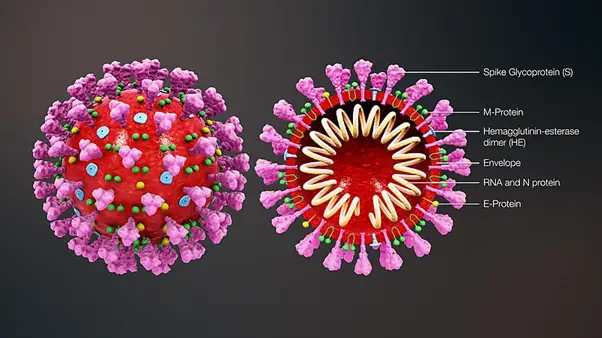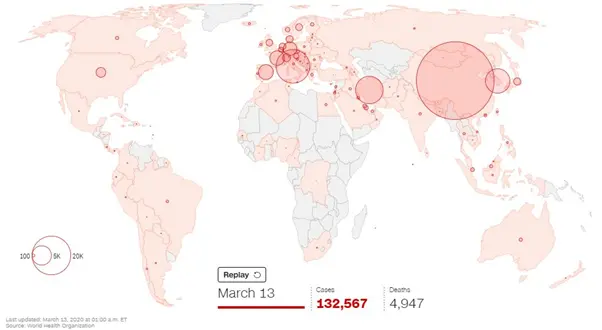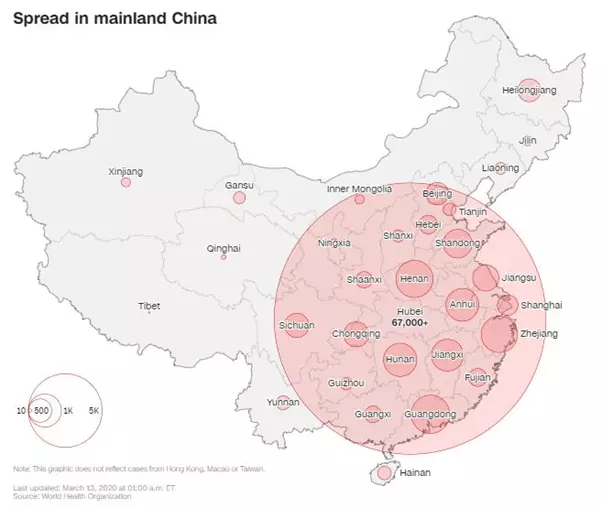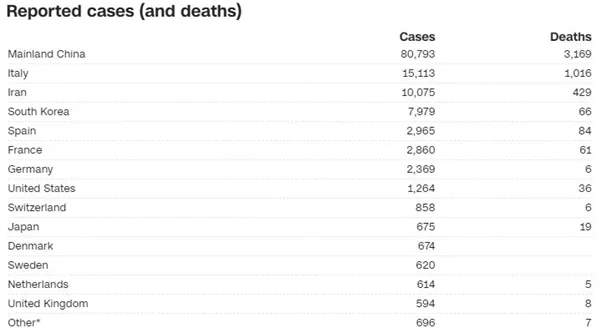Corona Virus Case Study: The Growing menace of COVID-19
Question
Task: What is COVID-19 and how Corona Virus Case Studies can help create rawness regarding the virus and strategies to reduce exposure?
Answer
Introduction
The recent COVID-19 also known as the corona virus outbreak has shook the world and has affected tens of thousands of people around the globe and has a fatality rate of around three thousand in over 50 countries. The current strain of the corona virus is said to have originated from the Wuhan region in China, in early December of 2019 (Sharma, Mudgal, Panada, Gupta, & Aggarwal, 2020). Since its inception it has spread at a rapid pace effecting people from different countries, and even shutting down whole cities and countries. This Coronavirus case study, provides in-depth report of the history of the corona virus, along with the symptoms, transmission and current scenario around the world. This coronavirus case study will also address the various ways in which the patients can be treated and preventive measures.
What is Corona Virus?
Corona Virus is a strain of virus belonging to the family of Coronaviridae. The word gets its name from the circular crown like projections on its surface. Corona is Latin for ‘crown’ or halo, hence the name ‘coronavirus’ (Kasmi, Khataby, Souiri, & Ennaji, 2020).
The first isolated incident of coronavirus was found in 1937, as an infectious bronchitis in birds. Even then it had the potential to destroy poultry stocks to a severe extent. Whereas, among humans termed as H-CoV, or human corona virus was first found in 1960s as common cold.
On this corona virus case study we explore the different strains of the virus in humans which have different implications on the human body in the form of a disease. The rate and volatility of its transmission is also affected by the nature of the strain. In this coronavirus case study, we have classified the stain on the basis of their presence and existence among humans. The known corona virus genuses are classified into four types, Alpha, Beta, Gamma, and Delta (Wilkinson, Joffrin, Lebarbenchon, & Mavingui, 2020). Out of which, the alpha and beta corona virus strain can infect mammals, such as humans, cats, pigs, and bats. Whereas, gamma coronavirus can infect birds including poultry, and the delta coronavirus affects both mammals and birds.
The most common types of the virus strain identified on this corona virus case study are, 229E (alpha), NL63 (alpha), OC43 (beta), HKU1 (beta) (Ahmad & Rodriguez-Morales, 2020). Out of which OC43 and 229E were among the first strains of coronavirus which was found among humans. These strains are the most commonly found in people in the colder regions and during the winter and spring season. Their diagnosis and treatment is easy as its symptoms are common cold and runny nose.
Amongst the other forms of the coronavirus strain are the Middle Eastern Respiratory Syndrome Corona Virus (MERS-CoV) and severe acute respiratory syndrome corona virus (SARS-CoV). Both of these strains are very rare and cause more severe complications among the patients.
MERS-CoV
Middle Eastern Respiratory Syndrome is a disease which is caused by a rare strain of coronavirus. It gets its name because its area of origin which was Saudi Arabia. It was first identified in 2012, and then spread to a major part of the Middle East, including countries, Saudi Arabia, Algeria, Oman, Turkey, Kuwait, UAE, Egypt, Qatar Jordan and more, and even out the Arabian Peninsula region Bangladesh, Austria, UK, China, Thailand, Philippines and South Korea. The biggest outbreak of MERS-CoV occurred in 2015, in South Korea, which originated from an individual who travelled from Saudi Arabia infecting a total of 186 people and claiming the lives of 36 people.
The nature of the MERS-CoV is zoonotic, meaning it can be transmitted between animals and human beings through direct or indirect contact. Though the actual origin of the virus is uncertain, scientists claim that it was transmitted from bats to camels and then to humans after careful analysis of different virus genomes (Dudas, Carvalho, A.Rambaut, & Bedford, 2018).
The symptoms which can be seen in an individual suffering from MERS are fatigue, fever, breathlessness, sneezing, and coughing. In human to human to transmission, MERS can spread through close contact with the host. As per a corona virus case study conducted in 2019, the fatality rate of MERS is 35.2% among the people who get infected.
SARS-CoV
Severe Acute Respiratory Syndrome is an illness caused by a specific strain of coronavirus, also known as SARS-CoV. It gets is name because of its effects on an infected patient. SARS-CoV was first identified as a distinct strain of coronavirus in 2003, whereas, the first instance of this virus in humans had been traced to November 2002, in the Guangdong province of China. The virus quickly spread to 26 countries causing a state of pandemic infecting more than 8000 people in killing about 800 people around the world. Among the countries who were majorly affected by this disease were, China, Hong Kong, Vietnam, Singapore, Taipei, Chinese, and Canada.
The virus once transmitted, had influenza like symptoms including, fever, dry coughing, malaise, myalgia, headache, diarrhoea, and chills. These symptoms vary from person to person, with absence of one of two in a particular patient, however fever was the one thing that was common amongst all. During the first couple of weeks, the virus effects slowly with only dry coughing and mild fever are evidents, however, in severe case it evolved rapidly causing developing respiratory distress requiring intensive care.
The source of origin of this strain of coronavirus is also unknown, however, research has claimed that started from bats in an unknown region of china, and then spread to civet cats which then reached human beings (BolBolles, Donaldson, & Baric, 2011). Among human beings the virus spreads after the first two weeks of getting attached to a host, when its effects start to get severe. The virus had a mortality rate of 9.6% among the ones infected. It was brought under control through strict measures of disinfection and quarantine. Since the virus mainly spread through person to person contact, thus the care givers were most vulnerable and became a common target of the virus. However, SAR-CoV outbreak was brought to an end through effective infection control measure from authorities.
Current Strain discussed on this corona virus case study
The 2019 novel coronavirus outbreak has picked up many names, putting people in a dilemma. The disease which is caused by the virus has been termed as COVID-19, which stands from Coronavirus Disease which began in 2019. Whereas, the particular strain of virus which causes the said disease is SARS-CoV-2, which stands for Severe Acute Respiratory Syndrome Corona Virus-2, because a similar strain of coronavirus had been previously identified and the current virus is said to have evolved from its predecessor. The name of the disease COVID-19 was given by WHO on 11th February 2020, whereas, the International Committee on Taxonomy of Viruses is responsible for naming the virus, SARS-CoV-2 on the same date as well (Wu, Ho, Huang, Jin, & al., 2020).
The current strain of corona virus which has been declared as a global epidemic by WHO, is said to have originated from the Wuhan province in China, in early December, 2019. The officials have claimed that the wet market called the Huanan Seafood Market in the region of Wuhan is the starting point of the virus outbreak. However, no concrete evidence has been found to prove this claim. This was first identified by the Chinese hospitals when increased numbers of cases were coming for people suffering from severe pneumonia (Huang, et al., 2020). Much like its predecessor virus strains SARS and MERS-Cov, the SARS-CoV-2 also originated from bats and then spread to humans. Researchers are still trying to find out how the virus made a species jump from bats to humans.
Replication of the virus
Coronaviruses comprise of single strip of RNA, enclosed by a membrane studded with small spikes of proteins. The virus is contains the longest genome of any RNA- virus – around 26,000 to 32,000 bases long, single strand of nucleic acid. The corona virus case study identified that the proteins form up a loop around the top of the virus, as seen under a microscope, giving it its name—"corona "which is Latin for" crown". Once the virus reaches the body, those spike proteins bind to the host cells, and the virus pours RNA into the nucleus of the cell, taking hold of the replication mechanism there to create additional viruses and hence the infection spreads (Chen, Liu, & Guo, 2020).

Figure 1: Structure of SARS-CoV-2
Transmission of Corona Virus
Although the research for definitive results regarding the transmission of the coronavirus is still going on, so at to provide comprehensive care to patients, the content about the transmission in this corona virus case study have been based on the limited research available.
As per most corona virus case study the nature of the disease and most of its symptoms are similar to influenza, researchers believe that the virus spreads through transfer of bodily respiratory fluids, which may be emitted from one human being to another. This transfer of fluids or mucus can be direct or through a medium as the corona virus has a short life span outside the body of the host cell (Chan, 2020).
This transfer of respiratory fluids among humans can occur in multiple ways, such as , through release of droplets into the air, while coughing and sneezing, which could reach a new host in the immediate vicinity, through direct touching in the form of hand shake or intimate contact can all transfer the virus from one person to another, transfer of virus through an intermediate medium such as touch a surface which has been touched by an individual carrying the virus recently then touching your own eyes, mouth or nose can also be a major cause of spread, and one other way in which the virus could spread is by consumption or coming in contact with the faeces of an animal carrying a disease. Although the evidence of that last mode of transmission is limited, it is still a prominent possibility, since that is how the disease reached from animals to humans in the first place.
Since the inception of the outbreak in China and all across the world, it has been observed that the there are several groups of population which are more vulnerable to contracting this disease than others. These groups of people have been identified as infants and toddlers, women going through pregnancy, and people over the age of 60. This is primarily because of lesser immunity and absence of antibodies.
Global Impact of COVID-19
The coronavirus outbreak has spread to every continent on the globe except Antarctica, in about 126 countries all over the world. Since the occurrence of the first case in China in December, the disease has now spread all across the world with 132,000 cases worldwide less than 3 months and the number is still on the rise. As per the time this corona virus case study was published, The world has organisation declared it a global health emergency due to its rapid rate of transmission and increasing rate of mortality.

Figure 2: Global COVID-19 Spread
As per CNN, 2020, the total number of patients who have been tested positive for coronavirus all across the world so far are 132,567 as of 13th March, 2020, with a total number of deaths at 4,947.
Out of the above mentioned cases on this corona virus case study, China has the highest number of reported cases of coronavirus with a total of 80,793 people being infected, and 3,196 dead so far . Soon after the outbreak China, issued measures to tackle the growing epidemic, by building new hospitals, deploying health officials for widespread survey and diagnosis, and putting the whole country under a lockdown.

Figure 3: COVID-19 Spread in China
Italy is right behind China, in the number of reported cases of coronavirus patients, at 15,113 and a mortality figure of 1016 as of the date this corona virus case study was published. Italy is followed by Iran, South Korea and Spain in the number of case. However, Italy and China had to take the most drastic measures to get the outbreak under control. Italy also issued a complete lockdown, suspending, schools, offices, and other places of gathering as well as transit, in efforts to contain the spread.

Figure 4: Corona Virus Statistics
There have been numerous cases in almost all parts of the countries in the world. This has been attributed to travelling. As most of the people who were diagnosed with coronavirus a history of travel to a place which was already facing rising cases of new patients. While travelling, since the effects of the SARS-CoV-2 take about one week to show, everyone in contact to the person carrying the virus, may have been exposed to the virus, thus contributing to the widespread epidemic. This is may be the reason, why even geographically isolated region have found new patients who have been infected. There have been almost 150 coronavirus cases in Australia which is an island continent (Pettersson, Manley, Hernandez, & CNN, 2020). It is suspected that most of the cases of coronavirus in Australia have occurred due to travelling patients. This is the case with most other countries of the world as well.
Economic Impact of the Corona Virus Outbreak
In addition to killing close to 5000 people and infecting over hundred thousand people, corona virus has brought whole countries at a complete stand still and affected the world economy very badly. The stock prices and bond yields are plummeting. Due to such huge concerns regarding its widespread infectious nature, governments all over the world have initiated containment protocols which means slowing down travel and halting major business operation which would result in a huge lose for every day . Since China is the world’s second largest economy and houses the manufacturing and other business operations of major companies of the world, locking down the whole country would mean, crashing the second largest economy in the world and ultimately hurting the global economy as well.
At the time this corona virus case study, the global economic growth forecast for the year 2020 which is still in its first quarter has seen a significant drop, amidst the current changes due the outbreak. The global economy was predicted to grow 2.9% in the year 2020, which has now changed to 2.4% due to the economic slowdown caused by corona virus (Ayittey, Ayittey, Chiwero, Kamasah, & Dzuvo, 2020).
Manufacturing sector is one of the key contributors to the GDP of the country. The PMI (Purchase Manager’s Index) is predicted to be contracting for the year 2020 for China as well as USA, meaning their economy will be badly hurt and the other countries in close relation with it as well such as Vietnam, Singapore and South Korea.
The stock prices have been majorly affected by the outbreak. The impact of corona virus on the global economy has spread fear among the investors and the descreasing economy of China has slowed down businesses lowering the stock prices.
The current economic slow down all around the globe will effect every country in the world, will set the development of some of the countries back significantly. It could even lead to a recession in many countries making things harder for the business owners, governments, and the common man. In addition, the global outbreak has cause the drop in the manufacturing processes of almost all countries, making growth slower and bringing whole economies at a stand still. The lockdown of a country drastically effects its economic status and even causes widespread panic which can lead to instability in the country if not guided properly (K.D.S.Yu & Aviso, 2020).
COVID-19: Symptoms of Coronavirus
At the time of this corona virus case study publications, the effects of the disease COVID-19 take more than one week to be evident, this a person having said illness may not even get diagnosed for it. Some of the early symptoms of the disease are common cold, and mild flu, which may be present on the first week of contracting the virus, however, it may vary depending on the immunity and lifestyle of an individual. Most people may recover easily, but if left untreated the COVID-19 has claimed the lives of thousands so far.
The symptoms one should look for in themselves of any person near them include:
- Coughing
- Sneezing
- Runny nose
- Sore Throat
- Issues in respiration
- Fatigue
- Fever
- Diarrhoea
- Pneumonia
Treatment and Prevention
Since the novel coronavirus 2019, cannot be cultivated in a laboratory easily like the rhinovirus, scientists have been facing difficulties in researching on the epidemic causing virus, to infer some necessary findings. The cure for the coronavirus has not been found yet, and because of the same reason, there is no vaccination for the virus yet.
However, even before WHO declared it as a global health emergency, scientist all over the world have been doing continuous research to find more information regarding the origin, spread, effects, treatments, and elimination of the virus.
Since this corona virus case study is regarding the current strain of coronavirus causing havoc is inadequate, people have been advised to take measures to avoid the spread of virus and get the treatment with over the counter drugs and get proper diagnosis if any of the above systems persists.
Some of the important preventive measures against the corona virus as per the World Health Organisation are:
- Wash hands frequently
- Keep a distance of at least 3 feet between people who are coughing or sneezing
- Avoid touching your eyes, nose and mouth constantly
- Follow respiratory hygiene by covering the mouth while sneezing coughing and yawning, with a tissue or a cloth
- Seek medical assistance, if you have fever, sever cough, respiration issues
- Avoid going in public if you have the above symptoms
- Avoid Over exertion and get enough rest
- Ensure proper hygine and mintain a clean germ free environment
- Use a humidifier when indoors
- Avoid Smoking and stay away from areas with heavy smoke concentrations
- Drink lots of fluid
Conclusion
This corona virus case study has identified that, the virus itself is not something new and unheard off, but has evolved prom its predecessors and took the world by storm. Despite health measure, the cases are continuing to rise in new countries and region. Though, the disease is cureable in healthy teens and young adults, the adults and senior population of the whole is at risk of getting this disease, due to less immunity and existence of other medical issues. This make them the most vulnerable to this disease. Science are still working tirelessly to find out new information which could possibly lead to the creation of a vaccine to the corona virus. This corona virus case study would updated periodically and report the current status of the virus.
References
Ahmad, T., & Rodriguez-Morales, A. (2020). Emergence of COVID-19 (formerly 2019-novel Coronavirus): a new threat from China. Revista Panamericana de Enfermedades Infecciosas, 37-38.
Ayittey, F., Ayittey, M., Chiwero, N., Kamasah, J., & Dzuvo, C. (2020). Economic impacts of Wuhan 2019?nCoV on China and the world. Journal of Medical Virology.
BolBolles, M., Donaldson, E., & Baric, R. (2011). SARS-CoV and emergent coronaviruses: viral determinants of interspecies transmission. Current opinion in virology, 1(6), 624-634.
Chan, J. Y. (2020). A familial cluster of pneumonia associated with the 2019 novel coronavirus indicating person-to-person transmission: a study of a family cluster. The Lancet, 395(10223), 514-523. corona virus case study
Chen, Y., Liu, Q., & Guo, D. (2020). Emerging coronaviruses: genome structure, replication, and pathogenesis. Journal of medical virology.
Dudas, G., Carvalho, L., A.Rambaut, & Bedford, T. (2018). MERS-CoV spillover at the camel-human interface. Elife, 7, 31257.
Huang, C., Wang, Y., Li, X., Ren, L., Zhao, J., & al., e. (2020). Clinical features of patients infected with 2019 novel coronavirus in Wuhan, China. The Lancet, 395(10223), 497-506.
K.D.S.Yu, K., & Aviso, K. (2020). Modelling the Economic Impact and Ripple Effects of Disease Outbreaks. Process Integration and Optimization for Sustainability, 1-4.
Kasmi, Y., Khataby, K., Souiri, A., & Ennaji, M. (2020). Coronaviridae: 100,000 Years of Emergence and Reemergence. In Emerging and Reemerging Viral Pathogens , Kasmi, Y., Khataby, K., Souiri, A. and Ennaji, M.M., 2020. Coronaviridae: 100,000 Years of Emergence and 127-149.
Pettersson, H., Manley, B., Hernandez, S., & CNN. (2020, March 13th). Tracking coronavirus’ global spread. CNN Health. Retrieved from https://edition.cnn.com/interactive/2020/health/coronavirus-maps-and-cases/
f, S., Mudgal, S., Panada, P., Gupta, P., & Aggarwal, P. (2020). Novel Coronavirus (2019-nCoV) Infection: Guidance Outlines on Infection Prevention and Control for Health Care Workers. Indian Journal of Community Health, 32(1).
Wilkinson, D., Joffrin, L., Lebarbenchon, C., & Mavingui, P. (2020). Partial RdRp sequences offer a robust method for Coronavirus subgenus classification. bioRxiv. corona virus case study.
Wu, Y., Ho, W., Huang, Y., Jin, D., & al., e. (2020). SARS-CoV-2 is an appropriate name for the new coronavirus. The Lancet.












